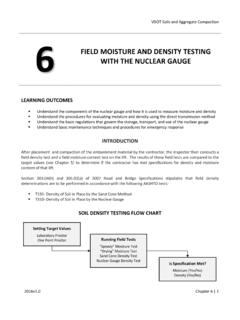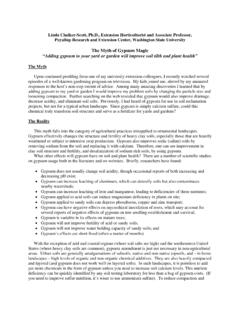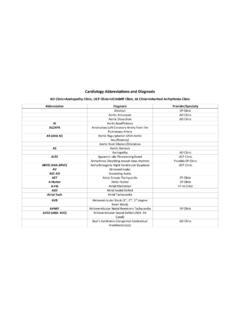Transcription of 19. ELECTRICAL LOGGING 19.1 Introduction - University of Leeds
1 Petrophysics MSc Course Notes ELECTRICAL LogsDr. Paul Glover Page logs are perhaps the most important tools available to a petrophysicist. This is because theyprovide a method for calculating the water saturation, upon which calculations of STOOIP are were also some of he first logs to be used, with Marcel and Conrad Schlumberger testing out anelectrical log for the first time in 1927 in the Pechelbronn field, first measurements were continuous recordings using 2 or 3 electrodes and a direct current.
2 Itwas discovered that high quality recordings of apparent resistivity could be obtained under favourableconditions of small diameter boreholes, high mud resistivities and shallow invasion in thick early tools are called electric LOGGING development of ELECTRICAL tools has henceforward been intense. There are now tools that can copewith extremely highly resistive muds (oil-based muds or gas as the borehole fluid), which rely uponelectromagnetic coupling and an induced alternating current (induction logs).
3 The induction logactually measures conductivity, and hence is sometimes called the conductivity log. The modern toolfor measuring resistivity in high salinity (low resistivity) muds is the laterolog, which focuses itscurrent into a thin sheet to improve vertical resolution and penetration depth. The laterologs measureresistivity in the conventional sense, and are usually referred to as resistivity tools. Both the inductionlogs and the laterologs come in different types, which are sensitive to different depths of penetrationinto the borehole.
4 Hence resistivity determinations for the invaded, partly invaded and undisturbedrock zones can be measured. In addition, there is a range of smaller ELECTRICAL devices (micro-resistivity tools), which are designed to measure the resistivity of mudcake. There are also Array Logs,which are state of the art tools, and ELECTRICAL measurements are used at high resolutions (small scale)to image the interior of the borehole Principle Uses of ELECTRICAL LogsThe main use of the ELECTRICAL tools is to calculate the water saturation of a reservoir formation, andhence the STOOIP.
5 Chapter 17 covered most of the important theory for this application, and Chapter1 introduced the use of the derived values when calculating ELECTRICAL tools also have a number of qualitative uses, principle of which are (i) indications oflithology, (ii) facies and electro-facies analysis, (iii) correlation, (iv) determination of overpressure,(iv) determination of shale porosity, (v) indications of compaction , and the investigation of Typical Responses of an ELECTRICAL ToolFigure shows the typical response of an ELECTRICAL tool in a sand/shale sequence.
6 Note the lowerresistivity in shales, which is due to the presence of bound water in clays that undergo surfaceconduction. The degree to which the sandstones have higher resistivities depends upon (i) theirporosity, (ii) their pore geometries, (iii) the resistivity of the formation water, (iv) the water, oil andgas saturations (oil and gas are taken to have infinite resistivity).Petrophysics MSc Course Notes ELECTRICAL LogsDr.
7 Paul Glover Page 247 Fig. Typical resistivity log Old ELECTRICAL LogsThese logs will be discussed briefly because data from them may still be encountered whenreanalyzing mature MSc Course Notes ELECTRICAL LogsDr. Paul Glover Page 248 Take an homogeneous and isotropic medium that extends to infinity in all directions.
8 Now pass acurrent from an electrode A in the medium to another B infinitely distant. We take the potential ofelectrode A to be some value VA = V, and that of electrode B to be zero, VB = 0. The current will flowradially (Fig. ), and generate spherical equipotential surfaces with electrode A at their centre. Athird electrode M placed near A will lie on one of these equipotential surfaces, whose radius is r. If weconnect electrode M to electrode B through a potential measuring device (voltmeter), it will show thevalue of the potential on the equipotential surface that passes through M, VM.
9 The resistivity of thematerial between A and M is the calculated as:()IVrIVVrRMA = = 44( )Here: V = the potential difference between A and M, the factor 4 r is defined by the geometry ofthe system (spherical symmetry), and it is assumed that A and M are close enough together for thecurrent I to be constant, even though it is spreading out with Current flow in an homogeneous isotropic types of resistivity tool have different geometrical factors that depend on their electrodearrangements.
10 These are calculated theoretically, and checked in tool theoretical scenario is the basis for the original tools: what are called the normal LOGGING distance AM = r is called the spacing. Two spacings were commonly used, a short normalspacing equal to 16 inches, and a long normal spacing equal to 64 inches. The longer the spacing, thegreater the depth of penetration of the current into the formation, but the lower its vertical the theory is developed for 3 electrodes, and this is how the first measurements were made, afour electrode arrangement soon became standard.

















